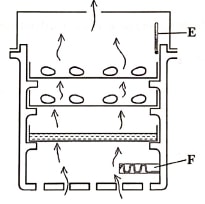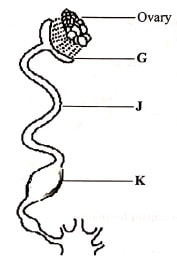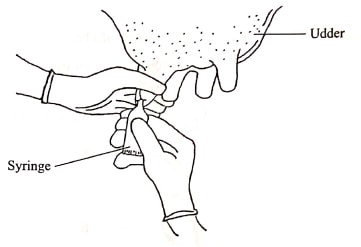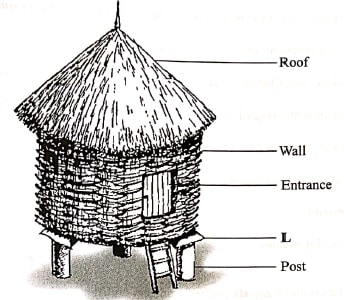SECTION A (30 marks)
Answer all the questions in this section
- State four effects of fleas in poultry.(2 marks
- Name two breeds of dairy cattle with the highest
- butter fat content (1 mark)
- milk yield (1 mark)
- State four ways in which vaccines are administered to livestock. (2 marks)
- State four characteristics of animals which require a high maintenance ration. (2 marks)
- State four microbial activities that occur in the rumen. (2 marks)
- Name four pests that attack bees. (2 marks)
- Name four mineral deficiency livestock disorders. (2 marks)
- State four control measures for fowl typhoid. (2 marks)
- State the function of each of the following:
- mallet (½ mark)
- trocar and canula (½ mark)
- garden line (½ mark)
- stock and die (½ mark)
- State four maintenance practices carried out on a wheelbarrow. (2 marks)
- State four limitations of biogas as a source of power on the farm. (2 marks)
- State four functional differences between disc and mouldboard ploughs. (2 marks
- State four advantages of the Kenya Top Bar Hive (K.T.B.H.) over the log hive. (2 marks)
- Distinguish between the following practices as used in livestock production:
- tupping and serving (1 mark)
- ringing and raddling (1 mark)
-
- Name the causal organism for East Coast Fever. (½ mark)
- State three ways in which infectious diseases spread from one animal to another. (1½ marks)
SECTION B (20 marks)
Answer all the questions in this section in the spaces provided.
- The diagram below illustrates a practice in poultry rearing.

- Identify the practice. (1 mark)
- Name the part labelled
E...................(1 mark)
F....................(1 mark) - Explain two activities not shown in the illustration but very important for the practice to succeed. (2 marks)
- The diagram below shows the reproductive system of a hen.

- Name the part labelled K (1 mark)
- State one function of each of the parts labelled
G...............(1 mark)
J................(1 mark) -
- What is the maximum number of eggs a hen can lay in a day? (1 mark)
- Give a reason for your answer in (c) (i) above. (1 mark)
- The diagram below illustrates a treatment practice for a cow's udder infected with mastitis.

- Name the causal organism for mastitis. (1 mark)
- Explain the treatment practice illustrated. (1 mark)
- How is mastitis infection detected in a lactating cow? (1 mark)
- How is an infected cow handled during milking to prevent spread of the disease to other animals? (2 marks)
- The diagram below shows a farm structure for storing grains

- Identify the farm structure. (1 mark)
- State the function of the part labelled L. (1 mark)
- State one disadvantage of the roofing material used on the farm structure. (1 mark)
- State two ways in which the structure is made ready for grain storage. (2 marks)
SECTION C (40 marks)
Answer any two questions from this section
-
- State five disadvantages of artificial insemination. (5 marks)
- State five differences between ruminant and non-ruminant digestive systems. (5 marks)
- Describe anaplasmosis (gall sickness) disease under the following sub-headings:
- causal organism (1 mark)
- modes of transmission (2 marks)
- symptoms (4 marks)
- control measures. (3 marks)
-
- State the functions of any six parts of a piggery unit. (6 marks)
- Explain six disadvantages of animal drawn implements. (6 marks)
- State eight symptoms of tapeworm infestation in cattle. (8 marks)
-
- Explain five precautions taken by dairy farmers to ensure clean milk production. (10 marks)
- Describe how chicken is dressed for sale. (10 marks)

Marking Scheme
SECTION A (30 marks)
Answer all the questions in this section
- State four effects of fleas in poultry.(2 marks)
- Irritation
- Anaemia
- Wounds damage on the skin
- Damaged raffled feathers
- Retarded growth
- Name two breeds of dairy cattle with the highest
- butter fat content (1 mark)
- Jersey
- Guernsey
- milk yield (1 mark)
- Fresian
- Aryshire
- butter fat content (1 mark)
- State four ways in which vaccines are administered to livestock. (2 marks)
- Through injections
- Orally through the mouth
- Through the nose/inhalation
- through the cloaca
- State four characteristics of animals which require a high maintenance ration. (2 marks)
- large animals
- young animals
- more active animals
- highly productive(yielding)animals
- State four microbial activities that occur in the rumen. (2 marks)
- Food fermentation
- Synthesis of vitamins
- Synthesis of amino acids
- Breakdown of proteins, amino acids and ammonia
- Breakdown of cellulose and carbohydrates to carbon (IV) oxide and volatile fatty acids
- Name four pests that attack bees. (2 marks)
- Honey badger
- Bee louse
- Wax moth
- Ants
- Name four mineral deficiency livestock disorders. (2 marks)
- Milk fever
- parakeratosis
- Goitre
- Enzootic noenatal ataxia(sway back in lambs)
- Anaemia
- Hypomagnesemia(Grass staggers)
- State four control measures for fowl typhoid. (2 marks)
- Kill and properly dispose infected birds
- Maintain proper hygiene
- Regular vaccination
- Obtain chicks from reliable sources
- Treatment using sulphur drugs
- State the function of each of the following:
- mallet (½ mark)
- Driving wood chisel
- trocar and canula(½ mark)
- Removal of accumulated gases which cause bloat in ruminants
- garden line (½ mark)
- Setting straight lines, measuring distances
- stock and die (½ mark)
- Cutting threads on pipes
- mallet (½ mark)
- State four maintenance practices carried out on a wheelbarrow. (2 marks)
- Greasing the moving parts
- Repairing broken parts
- Replacing worn out parts
- Cleaning after use
- Proper storage
- State four limitations of biogas as a source of power on the farm. (2 marks)
- High initial capital is required to construct the digester.
- Require high skilled labour
- It requires rearing of livestock to sustain gas production
- It is laborious in refilling with dung
- State four functional differences between disc and mouldboard ploughs. (2 marks
Disc Plough Mouldboard plough- Rolls over obstacles Rigid and slides along:
- Does not completely invert furrow slices. Completely inverts furrow slices
- Requires more secondary cultivations. Requires fewer secondary cultivations
- Ploughs at varying depths Ploughs at a uniform depth
- Not easily broken by obstacles Easily broken by obstacles.
- Requires less draft power. Requires more draft power.
- State four advantages of the Kenya Top Bar Hive (K.T.B.H.) over the log hive. (2 marks)
- Top bars can be removed and replaced to inspect the combs.
- Honey combs are harvested without disturbing the brood.
- Good quality honey is harvested without brood combs.
- More wax is harvested because combs are not returned to the hive
- It is easy to construct and repair.
- Utilizes queen excluder to separate honeycombs from the brood combs.
- Is cheap to construct and extract honey
- Distinguish between the following practices as used in livestock production:
- tupping and serving (1 mark)
- Tupping: Act of mating in sheep and goats
- Serving: Act of mating in cattle and pigs,
- ringing and raddling (1 mark)
- Ringing: Trimming of wool around the sheath of the penis to facilitate mating in sheep
- Raddling: Is the fitting of rams with breeding chutes painted in different colours or painting of rams in different colours on the underside to identify sires of lambs, infertile ewes and ewes with repeated heat
- tupping and serving (1 mark)
-
- Name the causal organism for East Coast Fever. (½ mark)
- Protozoa: Theirelia pava
- State three ways in which infectious diseases spread from one animal to another. (1½ marks)
- Through contact
- Through inhalation;
- Through ingestion;
- Name the causal organism for East Coast Fever. (½ mark)
SECTION B (20 marks)
Answer all the questions in this section in the spaces provided.
- The diagram below illustrates a practice in poultry rearing.
- Identify the practice. (1 mark)
- Artificial incubation
- Name the part labelled
E................... Thermometer(1 mark)
F.................... Source of heat(1 mark) - Explain two activities not shown in the illustration but very important for the practice to succeed. (2 marks)
- Egg turning to prevent chicks from sticking on shells
- Cleaning and disinfection to ensure proper hygiene/destro diseases agents
- Egg candling to remove infertile, broken and abnormal eggs
- Identify the practice. (1 mark)
- The diagram below shows the reproductive system of a hen.
- Name the part labelled K (1 mark)
- Uterus/shell gland
- State one function of each of the parts labelled
G............... Site of fertilization; addition of chalazae(1 mark)
J................ Addition of thick albumin; addition of water and mineral salts; addition of shell membarane(1 mark) -
- What is the maximum number of eggs a hen can lay in a day? (1 mark)
- one
- Give a reason for your answer in (c) (i) above. (1 mark)
- It takes 24 hours for an egge to form
- What is the maximum number of eggs a hen can lay in a day? (1 mark)
- Name the part labelled K (1 mark)
- The diagram below illustrates a treatment practice for a cow's udder infected with mastitis.
- Name the causal organism for mastitis. (1 mark)
- Bacteria-Streptococcus agalatiae / Staphylococcus urens:
- Explain the treatment practice illustrated. (1 mark)
- Alter milking, the infected teat/quarter is infused with antibiotics to destroy/kill the bacteria:
- How is mastitis infection detected in a lactating cow? (1 mark)
- By stripping milk into a strip cups, before actual milking starts.
- Watery milk/bloody milk/clot/pus/ on the strip cup indicate mastitis infection
- How is an infected cow handled during milking to prevent spread of the disease to other animals? (2 marks)
- Milk the infected animal last: milk the infected quarter last and discard the milk:
- Use Separate udder cloths for each animal:
- Name the causal organism for mastitis. (1 mark)
- The diagram below shows a farm structure for storing grains
- Identify the farm structure. (1 mark)
- Traditional granary
- State the function of the part labelled L. (1 mark)
- Prevent entry of rats into the store
- State one disadvantage of the roofing material used on the farm structure. (1 mark)
- Prone to damage by insects; fire risk; less durable
- State two ways in which the structure is made ready for grain storage. (2 marks)
- Cleaning
- Dusting:
- Clearing the vegetation around the granary:
- Repairing/replacing worn out broken parts:
- Identify the farm structure. (1 mark)
SECTION C (40 marks)
Answer any two questions from this section
-
- State five disadvantages of artificial insemination. (5 marks)
- Harmful traits can be spread quickly by one bull to the offsprings sired;
- Requires skilled labour,
- Low chances of conception;
- More laborious than natural mating:
- Dificult to detect heat signs
- Storage and transportation equipment are expensive.
- State five differences between ruminant and non-ruminant digestive systems. (5 marks)
- Ruminants Non-ruminants
- Chew the cud Do not chew the cud.
- Four chambered stomach One stomach.
- Regurgitates food Does not regurgigate
- Can digest cellulose Cannot digest cellulose except animals with functional caecum;
- Lack ptyalin in saliva Have ptyalin in saliva.
- Digestion and absorption mainly occurs in the rumen Occurs in the .Small intestines.
- Have alkaline saliva Saliva is neutral
- Describe anaplasmosis (gall sickness) disease under the following sub-headings:
- causal organism (1 mark)
- Protozoal Anaplasma marginale
- modes of transmission (2 marks)
- Blue ticks; contaminated surgical instruments; hypodermic needles; contaminated blood; biting insects
- symptoms (4 marks)
- Fever
- Constipation
- Pale eyes, gums and lips
- Reduced milk production
- Anaemia
- control measures. (3 marks)
- Control ticks; and biting insects:
- Treatment using intramuscular injections of antibiotics; and iron giving injections;
- causal organism (1 mark)
- State five disadvantages of artificial insemination. (5 marks)
-
- State the functions of any six parts of a piggery unit. (6 marks)
- Food store: Storage of pig feeds.
- Records room: Keeping sced and weight records.
- Farrowing pen: For furrowing and rearing piglets.
- Gilts pén: Rearing weaned females upto service age.
- Boar's pen: Houses the breeding boar; for mating.
- In-pig pen: Houses pregnant pigs awaiting forrowing.
- Weaners/fatteners pen: Houses piglets after weaning up to the age of six months.
- Running yard: Used for dunging and basking.
- Water troughs/drinking nipples: Used as watering points for pigs
- Explain six disadvantages of animal drawn implements. (6 marks)
- State eight symptoms of tapeworm infestation in cattle. (8 marks)
- State the functions of any six parts of a piggery unit. (6 marks)
-
- Explain five precautions taken by dairy farmers to ensure clean milk production. (10 marks)
- Milking equipment should be clean
- Clean milking parlour/shed.
- The udder should be cleaned before milking.
- The milkman should be clean and healthy.
- The cows should be tested for mastitis before milking.
- Cows with mastitis should be milked last and milk disposed of.
- The milk should be sieved/filtered after milkin2.
- The milk should be stored in a cool dry place/proper storage.
- Cow should be healthy/check the cows regularly for milk-borne disease.
- The milk should be covered after milking.
- Feeds that can taint milk should be avoided/equipment that can taint milk should be avoided.
- Milk should be cooled immediately to reduce bacterial multiplication
- Chip hair around udder and flank.
- Describe how chicken is dressed for sale. (10 marks)
- Explain five precautions taken by dairy farmers to ensure clean milk production. (10 marks)
Download KCSE 2019 Agriculture Paper 2 Questions With Marking Scheme.
Tap Here to Download for 50/-
Get on WhatsApp for 50/-
Why download?
- ✔ To read offline at any time.
- ✔ To Print at your convenience
- ✔ Share Easily with Friends / Students

